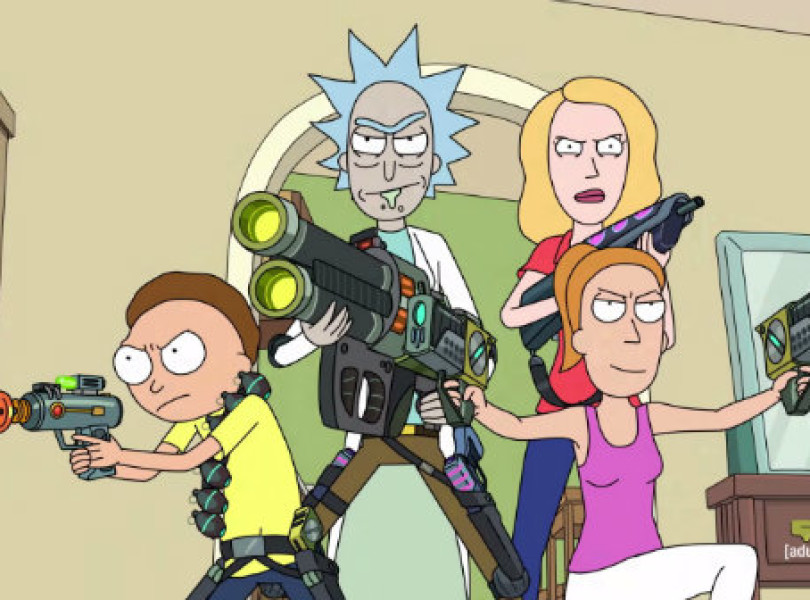Tiny Rick!!!
Warning: Full spoilers for Rick and Morty: Season 2 below.
When a show is as clever and inventive as Rick and Morty, its only real competition is itself. The show quickly honed its voice in its first season, setting a pretty high bar for the second season to meet this year. And while a few episodes were guilty of rehashing old concepts, as a total package this season did manage to outdo the first.
One of the more interesting wrinkles with this season was the increased focus on continuity between episodes. While each new installment is still largely standalone, the characters have become more prone to referencing past adventures. The show even built up a supporting cast of sorts, particularly when it came to the recurring appearances of Birdperson and Tammy. The show never got too hung up on continuity. Rather, creators Justin Roiland and Dan Harmon seemed to know just how hard to lean on it as a storytelling device so that some developments (particularly in the finale) carried more weight.
This emphasis on continuity was especially evident in the premiere episode, “Total Rickall,” which served as a direct continuation of the Season 1 finale “Ricksy Business.” Rick’s decision to abuse of time travel to clean up the mess from his house party wound up splitting the timestream into four pieces, each of which unfolded simultaneously on screen. It was a clever concept that was executed with plenty of intelligence and humor. And that pretty much set the tone for the entire season. Many episodes hinged on high-concept storytelling mixed with plenty of hilarity and a dash of poignant character moments. Whether it was Rick hanging out with his ex-girlfriend (a collective consciousness occupying an entire planet’s worth of people) in “Auto-Erotic Assimilation” or the incredibly bizarre locked room mystery that was “Total Rickall,” there was rarely a dull moment the entire season.
This season built pretty significantly on the previous season’s revelations about Rick being a profoundly unhappy man. Rick had some real emotional low points over the course of these episodes, including showing a bout of suicidal behavior in “Auto-Erotic Assimilation” and retreating into a teenager’s body in “Big Trouble in Little Sanchez.” But our drunken hero also showed signs of positive growth this year, showing genuine love and affection for his family from time to time and even sacrificing his freedom to save them in the finale.
One area this season improved was in allowing all the members of the Smith family to shine. Morty himself became a slightly more assertive character, showing that he is growing and evolving thanks to his misadventures with Grandpa Rick. His evolution was key in “Look Who’s Purging Now,” where all his pent-up rage and sexual frustration exploded onto the screen in a violent orgy of destruction. In his own way, Morty is as emotionally disturbed as his grandfather, which makes those rare moments when Rick protect’s Morty’s innocence that much more endearing.
Meanwhile, Summer essentially became the unofficial third member of their group in the aftermath of “Total Rickall,” which was a nice change from her being the show’s stereotypical surly teenage girl. Even Beth and Jerry were put to better use. While some episodes still played them as the straight-laced, boring counterpoints to Rick, Morty and Summer, others allowed them to join in on the craziness. “Big Trouble in Little Sanchez” was great about taking their familiar marriage woes and using them as a springboard for something bigger and crazier.
There were some weeks where it seemed Rick and Morty was its own worst enemy. In a series that prides itself on high-concept storytelling, any case where the show is slightly less innovative or where it repeats old storylines is bound to stick out. “Get Schwifty” was one example of this problem. That episode hinged on an “intergalactic American Idol” concept that never quite gelled or lived up to the show’s usual standard.
There was also “Interdimensional Cable 2: Tempting Fate,” the one case where the increased emphasis on continuity might have done the show a disservice. This episode was a direct sequel to Season 1’s classic “Rixty Minutes,” repeating the concept of Rick modifying a TV set to pick up broadcasts from across the multiverse. No matter how many times the characters acknowledged the fact that they were rehashing an old storyline, it didn’t help that episode feel as fresh or funny as the original.
But really, if episodes like “Get Schwifty” and “Interdimensional Cable 2” are the worst Rick and Morty has to offer, that speaks a lot for the show’s overall quality. It’s rare to see an animated sitcom of such wit and intelligence, and Roiland and Harmon can be forgiven if not every installment is a home run.
For a show that started life as an adults-only Back to the Future parody, Rick and Morty has sure developed into something special. The second season continued the formula of merging high-concept sci-fi storytelling with biting humor and a dash of emotionally complex character development for good measure. Occasionally this season was guilty of recycling elements from the first, but as a complete package it managed to outdo its predecessor. The bar is now set even higher for Season 3.




